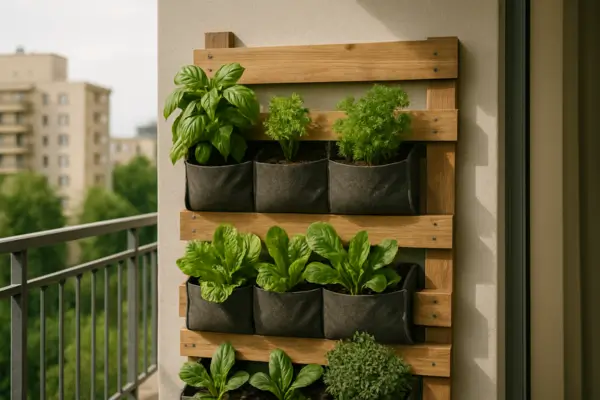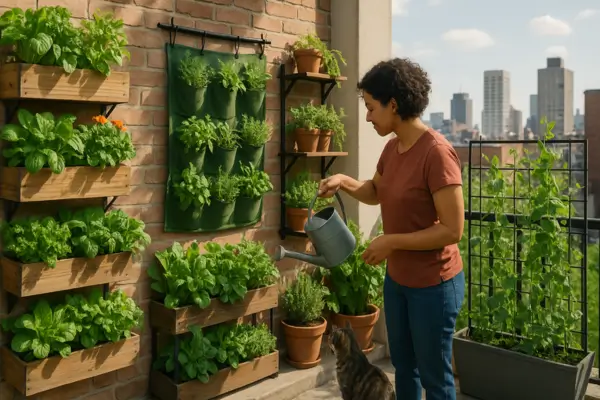Living in a bustling city often means sacrificing green spaces for concrete jungles. Limited square footage, tiny balconies, and lack of backyard gardens can make it challenging to connect with nature. But what if you could transform even the smallest urban space into a thriving green oasis? Enter vertical gardening—a simple, sustainable solution for city dwellers who crave greenery without compromising on space.
Vertical gardens are more than just a trendy design feature; they’re a practical way to grow plants upward instead of outward. Whether you have a sunny apartment wall, a narrow balcony, or just a windowsill, vertical gardening lets you cultivate herbs, flowers, and even vegetables in a compact, eco-friendly way. Beyond saving space, these living walls improve air quality, reduce urban heat, and bring a calming touch of nature into your home—boosting mental well-being in the process.
In this guide, we’ll explore how anyone—even those without a green thumb—can create a simple and sustainable vertical garden using low-cost materials, easy-care plants, and clever DIY techniques. Ready to turn your urban space into a lush retreat? Let’s dig in! 🌿
Why Choose Vertical Gardens? (DIY-Focused & Conversational)
Look, I get it—city living often means choosing between a tiny balcony or that “luxury” windowsill your landlord calls “outdoor space.” But here’s the secret: You don’t need ground to grow. Vertical gardens are the ultimate urban hack for plant lovers who refuse to let a little thing like “no yard” stop them.
Space Efficiency: Grow a Jungle in Your Closet (Okay, Maybe Not That Far)
Let’s be real—apartments weren’t designed for gardeners. But that blank wall above your Ikea sofa? Prime real estate. Here’s how people are cheating the system:
- The “Herb Wall” Side Hustle: My friend Maria grows basil, mint, and thyme in repurposed rain gutters on her fire escape. (Yes, her margaritas now feature “homegrown” mojito mint. She’s insufferable.)
- Pallet Problems: That wooden pallet behind the bodega? Flip it vertically, stuff it with soil, and boom—instant strawberry garden. (Warning: You’ll feel weirdly smug when the first berry appears.)
- Shower Plants (No Judgement): If your bathroom gets light, hanging air plants or ferns in suction-cup planters means you can jungle-shower like a spa commercial.
Sustainability: Your Secret Rebellion Against Concrete
Cities are basically heat-radiating, pollution-speaking concrete boxes. But your vertical garden? It’s a tiny act of rebellion. Here’s why:
- The “I’m-Not-Waiting-for-Politicians” Air Filter: NASA says houseplants scrub toxins. A wall of peace lilies = your personal clean-air factory.
- The “Bees Please” Effect: Even a small vertical garden with lavender or rosemary helps pollinators. (Take that, sterile downtown plazas!)
- Trash to Treasure: My favorite vertical garden? A retired shoe organizer stuffed with cilantro and parsley. Total cost: $0.
Health Benefits: Because Plants > Therapy (Sometimes)
Let’s talk about the real ROI:
- The “I-Killed-It-Again” Redemption Arc: Nothing boosts confidence like keeping a succulent alive for more than 3 months.
- Instant Zen: Studies show just looking at greenery lowers stress. Your 3am anxiety scroll? Replace it with staring at your pothos.
- Snackable Gardening: Nothing tastes better than a tomato you grew yourself. (Even if it’s the size of a grape.)
Try This Tonight:
Grab an empty plastic bottle, cut it sideways, fill it with soil, and stick in a $3 basil plant from Trader Joe’s. Hang it with twine. Congrats—you’ve just started.
Next up: The stupid-easy types of vertical gardens even black-thumbed humans can’t mess up.
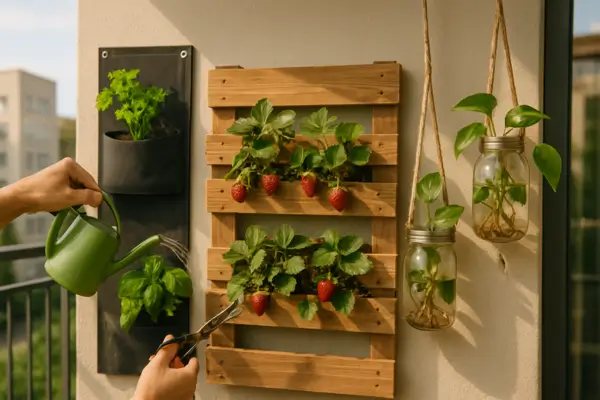
Vertical Gardens Made Simple: 5 Approaches for Any Space
Got a blank wall, a balcony, or just a stubborn desire to grow something? Vertical gardening is your answer. Here’s a straightforward breakdown of five easy methods—complete with real-world examples and practical tips.
1. Wall-Mounted Planters (The Beginner’s Best Friend)
What You Need: Fabric pocket planters ($15-$30) or modular plastic systems
Best For: Herbs (basil, thyme, mint), small greens (lettuce, spinach)
Why It Works:
- Installs in minutes with basic tools
- Keeps plants organized and accessible
Pro Tip: Start with a 6-pocket herb garden near your kitchen window
2. Hanging Gardens (The Space-Saver)
What You Need: Hooks, macramé hangers, or repurposed containers
Best For: Trailing plants (pothos, philodendron), cherry tomatoes
Why It Works:
- Utilizes overhead space most people ignore
- Easy to adjust for optimal sunlight
Try This: Hang mason jars with herb cuttings in water near a sunny window
3. Pallet Gardens (The Upcycler’s Dream)
What You Need: 1 wooden pallet, landscape fabric, staple gun
Best For: Strawberries, succulents, mixed flower arrangements
Why It Works:
- Completely free if you find discarded pallets
- Creates instant vertical planting space
Important: Always sand pallets and line with fabric to prevent soil loss
4. Tiered Shelves (The High-Capacity Option)
What You Need: Ladder shelf or wall-mounted shelves
Best For: Combining different plant types (herbs, flowers, small veggies)
Why It Works:
- Creates microclimates (sun lovers up top, shade plants below)
- Makes watering and harvesting easier
Smart Buy: The IKEA Bittergurka spice rack makes a perfect mini herb shelf
5. Living Walls (The Showstopper)
What You Need: Modular living wall system ($50-$300)
Best For: Creating an impressive green focal point
Why It Works:
- Some systems include self-watering features
- Can grow dozens of plants in minimal floor space
Start Small: Try a 4-panel indoor herb garden before committing to large systems
Choosing Your System
Consider these factors:
- Time: Pallets require DIY skills; pocket planters are instant
- Budget: Hanging gardens can cost under $20; living walls $100+
- Goals: Edibles need more sun than decorative plants
Maintenance Tip: All vertical gardens dry out faster than ground plantings—check soil moisture every 2-3 days.
Coming Next: We’ll cover the best plants for vertical success (and which ones to avoid).
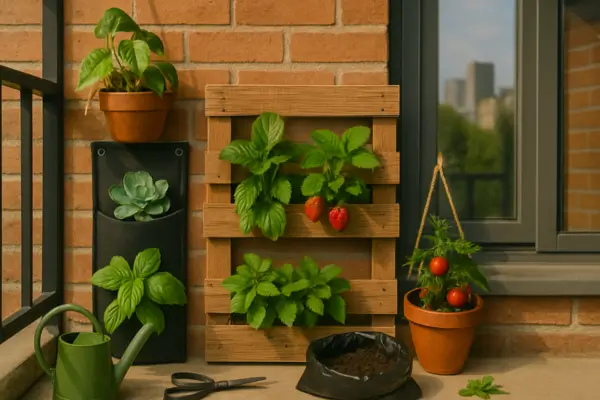
Choosing the Right Plants for Your Vertical Garden
Not all plants thrive in vertical setups—some wilt dramatically, while others grow like they’re competing for a gold medal. Here’s how to pick the perfect green (or edible) candidates for your vertical garden, whether you’re a forgetful waterer or an aspiring urban farmer.
1. Low-Maintenance Options (For the “I Forget Plants Exist” Crowd)
If your plant care routine is sporadic at best, these hardy survivors won’t hold a grudge:
- Succulents (Sedum, Echeveria) – Thrive on neglect, need minimal water
- Pothos & Philodendron – Grow in low light, bounce back from underwatering
- Ferns (Boston, Maidenhair) – Love humidity, perfect for shady balconies or bathrooms
- Herbs (Mint, Oregano, Thyme) – Almost impossible to kill (mint will take over if you let it)
Pro Tip: Stick to plants that tolerate drying out—vertical planters drain faster than regular pots.
2. Edible Plants (For the “I Want to Eat My Decor” Approach)
Why buy herbs when you can grow them right on your wall? These edibles work well in vertical setups:
- Leafy Greens (Lettuce, Spinach, Kale) – Fast-growing, harvest as you need
- Strawberries – Thrive in pockets or hanging planters (just give them sun)
- Cherry Tomatoes – Choose compact varieties like ‘Tumbling Tom’ for hanging baskets
- Herbs (Basil, Parsley, Cilantro) – Snip fresh for cooking (tastes 100x better than store-bought)
Warning: Avoid large veggies (zucchini, pumpkins)—they’ll topple your setup.
3. Climate & Light Considerations (No One-Size-Fits-All Here)
Your plants’ survival depends on two things: sunlight and temperature.
Indoor Vertical Gardens
- Low Light? Stick to pothos, snake plants, or ferns.
- Bright Window? Herbs, succulents, and cherry tomatoes will thrive.
- Humidity-Lovers? Try ferns or air plants in bathrooms.
Outdoor Vertical Gardens
- Full Sun (6+ hours) – Strawberries, basil, most succulents
- Partial Shade – Lettuce, mint, parsley (they’ll bolt in too much heat)
- Windy Balcony? Secure plants well—flimsy setups can tip over.
Plants to Avoid in Vertical Gardens
- Heavy or Sprawling Plants (squash, melons) – They’ll pull your setup down.
- High-Water Demanders (watercress, celery) – Vertical gardens dry out fast.
- Deep-Rooted Plants (carrots, radishes) – They need more soil than most vertical setups provide.
Final Tip: Start Simple
If you’re new to vertical gardening, begin with 3-4 easy plants (like herbs + pothos). Once you get the hang of watering and light needs, expand your green empire.
Next Up: How to build your vertical garden on a budget (with upcycled materials).
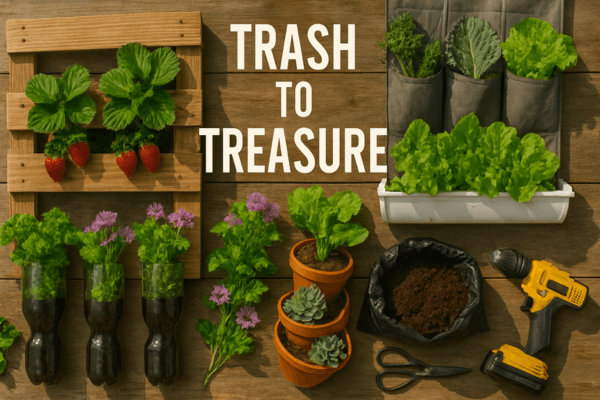
Sustainable Vertical Gardens: DIY Tips for Thrifty Urban Gardeners
Want a lush vertical garden without the guilt (or cost) of buying all-new materials? The secret is repurposing everyday items into planters and systems that work smarter, not harder. Here’s how to build a sustainable vertical garden—from self-watering hacks to homemade fertilizer.
1. Eco-Friendly Containers: Trash Turned Treasure
Why buy planters when your recycling bin is full of free options?
Plastic Bottles & Cans
✅ Best for: Herbs, strawberries, small greens
🔧 How to Do It:
- Cut a plastic bottle horizontally, poke drainage holes, and hang with twine.
- Use tin cans (remove labels, add holes) for a rustic look.
💡 Pro Tip: Paint bottles/cans with non-toxic paint to block sunlight (prevents algae growth).
Fabric Pouches (No-Sew Option)
✅ Best for: Lettuce, spinach, shallow-rooted plants
🔧 How to Do It:
- Repurpose an old shoe organizer (the hanging kind). Fill pockets with soil and plant.
- Use burlap coffee sacks as breathable plant pouches.
Broken Terracotta Pots?
✅ Best for: Succulents, trailing plants
🔧 How to Do It:
- Stack broken pieces vertically in a frame, fill gaps with soil, and tuck plants in.
2. Self-Watering Systems (For the Forgetful Gardener)
Stop playing the “did I water today?” guessing game.
Bottle Drip System
🔧 How to Do It:
- Take a plastic bottle, poke tiny holes in the cap.
- Fill with water and invert it into the soil near plant roots.
🌱 Works best for: Potted herbs, small veggies.
Wick Watering (Set It & Forget It)
🔧 How to Do It:
- Place a glass jar above your planter, run a cotton rope from the jar into the soil.
- The rope slowly draws water down as needed.
💧 Ideal for: Vacation-proofing small setups.
Olla Pot Hack
🔧 How to Do It:
- Bury an unglazed terracotta pot in your vertical planter, fill with water.
- Plants drink through the porous clay as needed.
3. Composting for Vertical Gardens (Free Fertilizer!)
No yard? No problem. Even tiny spaces can compost.
Bokashi (Indoor-Friendly)
✅ What to Add: Fruit scraps, coffee grounds, veggie peels (no meat/dairy).
🔧 How to Do It:
- Layer scraps in an airtight bucket with bokashi bran.
- Drain liquid weekly (dilute 1:100 to fertilize plants).
Worm-Free “Lazy Compost”
✅ Best for: Balcony gardeners
🔧 How to Do It:
- Bury kitchen scraps directly in planters (banana peels = potassium boost).
- Cover with mulch to avoid smells.
Compost Tea (Instant Plant Food)
🔧 How to Do It:
- Steep compost in water for 24 hrs, strain, and pour on plants.
🌿 Bonus: Adds beneficial microbes to soil.
Final Tip: The 3 Rules of Sustainable Vertical Gardening
- Drainage is Non-Negotiable – Always add holes to containers.
- Start Small – Test one DIY system before scaling up.
- Observe & Adapt – Plants will tell you what’s working (drooping = thirsty, yellow leaves = too much water).
Next Up: How to arrange your plants for maximum growth (and Instagram appeal).
Budget-Friendly Vertical Gardens: Big Impact, Tiny Budget
Who says you need deep pockets to create a lush vertical garden? Whether you’re a thrifty DIYer or just want to test the waters before investing, these wallet-friendly ideas deliver serious greenery without the sticker shock.
1. Upcycled Projects: Turning Trash into Treasure
Why spend money when your home is full of free planters?
Old Shoe Organizer Garden
✅ Best for: Herbs, lettuce, strawberries
💰 Cost: Free (if you have one)
🔧 How to Do It:
- Hang a fabric shoe organizer on a fence or balcony railing.
- Fill each pocket with potting mix and plant.
- Water carefully—fabric drains fast!
Pro Tip: Use the top pockets for mint (aggressive grower) and bottom ones for shade-loving parsley.
Gutter Garden
✅ Best for: Shallow-rooted greens (arugula, spinach)
💰 Cost: $10-15 (for vinyl gutters at hardware stores)
🔧 How to Do It:
- Cut gutters into 2-ft sections.
- Drill drainage holes every 6 inches.
- Mount with brackets on a sunny wall.
Bonus: Paint gutters with chalkboard paint to label plants.
Wooden Crate Stack
✅ Best for: Succulents, trailing flowers
💰 Cost: Free (check behind grocery stores)
🔧 How to Do It:
- Stack crates vertically and secure with zip ties.
- Line with burlap to hold soil.
- Plant drought-tolerant species—crates dry out quickly.
2. Affordable Kits: Ready-Made Systems Under $50
For those who want instant gratification (no judgment).
Pocket Planter Panels
🌿 Example: “Gardenfelt Vertical Planter” ($25 for 4 pockets)
✔ Pros: Lightweight, easy to move indoors in winter
✖ Cons: Small soil capacity (stick to herbs)
Hanging Tiered Shelf
🌿 Example: “Mindful Designs 3-Tier Hanging Planter” ($38)
✔ Pros: Fits 12+ small plants, no tools needed
✖ Cons: Requires sturdy ceiling hook
Modular Plastic Grid
🌿 Example: “Urbio Magnetic Planters” ($45 for starter set)
✔ Pros: Stick to metal surfaces (fridges, filing cabinets)
✖ Cons: Only holds tiny plants
Hot Tip: Check Facebook Marketplace for secondhand kits—people often sell unused systems for half price!
3. Community Swaps: Gardening Without Spending a Dime
Your neighbors are your best resource.
Plant Cuttings Exchange
🌱 How It Works:
- Post in local groups: “Trading pothos cuttings for spider plant babies!”
- Meet at community gardens or libraries.
Tool & Material Shares
🔨 Smart Asks:
- “Anyone have leftover potting soil I can take off your hands?”
- “Can I borrow your drill for a pallet project?”
Seed Swaps
🌻 Where to Find Them:
- NextDoor or Buy Nothing groups
- Public libraries (many now have seed banks!)
Real-Life Win: One reader got all her starter plants by offering homemade kombucha in trade.
Budget Hack Comparison Table
| Method | Cost Range | Skill Level | Best Plants |
| Shoe Organizer | $0-$10 | Beginner | Herbs, strawberries |
| Gutter Garden | $10-$20 | Intermediate | Leafy greens |
| Secondhand Kits | $15-$50 | Beginner | Small herbs/flowers |
| Community Swaps | Free! | Any | Whatever’s available |
Final Tip: Start Small, Scale Smart
- Week 1: Try the shoe organizer hack.
- Week 3: Add a $20 pocket panel.
- Month 2: Trade for new plants to expand.
Next Up: How to keep your budget garden thriving (water hacks, pest control, and seasonal tweaks).
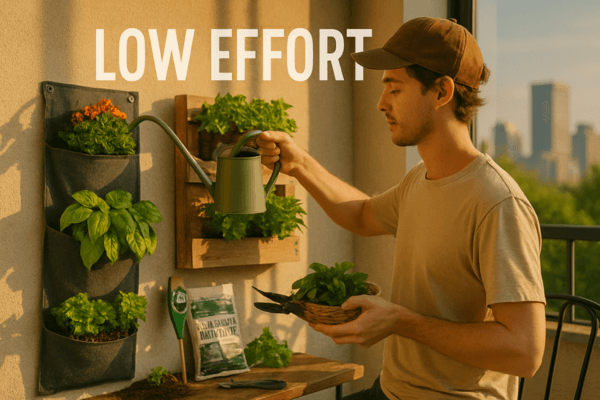
Keep It Alive: Low-Effort Care for Thriving Vertical Gardens
So you’ve built your vertical garden—now what? Unlike traditional gardens, vertical setups have unique needs (hint: gravity isn’t always your friend). Here’s how to keep your plants happy with minimal fuss.
1. Watering Wisdom: The Golden Rules
Vertical gardens dry out FAST. Here’s how to hydrate like a pro:
The Finger Test (No Gadgets Needed)
- Morning Ritual: Stick your finger 1″ into the soil.
- Dry? Water until it drips from the bottom.
- Damp? Skip a day.
- Pro Tip: Group plants with similar thirst levels (e.g., keep succulents separate from water-loving ferns).
Self-Watering Hacks for Lazy Gardeners
- Bottle Drip System: Fill an upside-down wine bottle with water and bury the neck in soil for slow hydration.
- Ice Cube Trick: Place 2-3 cubes at the base of plants in hot weather—melts slowly to prevent runoff.
Warning: Overwatering kills more vertical gardens than neglect. Ensure drainage holes are clear!
2. Pruning & Pest Control (Without Toxic Chemicals)
Your tiny jungle needs occasional grooming—here’s the painless approach:
Pruning for Productivity
- Herbs & Edibles: Snip tops regularly to encourage bushiness (never take more than 1/3 of growth).
- Trailing Plants: Trim leggy vines to maintain shape (propagate cuttings in water for free plants!).
Natural Pest Warfare
| Pest | DIY Remedy |
| Aphids | Spray with diluted castile soap + water |
| Fungus Gnats | Sprinkle cinnamon on soil |
| Spider Mites | Wipe leaves with neem oil solution |
Prevention Tip: Add crushed eggshells to soil to deter slugs (works for outdoor setups).
3. Seasonal Adjustments (Because Plants Don’t Use Calendars)
Your garden’s needs change with the weather—stay ahead with these tweaks:
Summer Survival Guide
- Shade Cloth: Protect delicate greens from scorching with an old sheer curtain.
- Watering 2x/Day: Check soil in mornings and evenings during heatwaves.
Winter Prep for Outdoor Gardens
- Move Sensitive Plants: Bring herbs like basil indoors before frost.
- Mulch Roots: Use straw or shredded leaves to insulate perennial plants.
Spring & Fall Refreshes
- Replace Soil: Refresh potting mix annually to replenish nutrients.
- Rotate Plants: Swap shade-lovers (like lettuce) into cooler spots as seasons change.
Troubleshooting Cheat Sheet
| Symptom | Likely Cause | Quick Fix |
| Yellow Leaves | Overwatering | Let soil dry completely |
| Brown Tips | Underwatering/low humidity | Mist leaves or add pebble tray |
| Leggy Growth | Not enough light | Move to brighter area or add grow light |
Final Tip: The 5-Minute Weekly Checkup
- Monday: Quick water check + remove dead leaves.
- Friday: Scan for pests + prune if needed.
Next Up: How to propagate your plants for infinite free greenery (stem cuttings, division, and more).
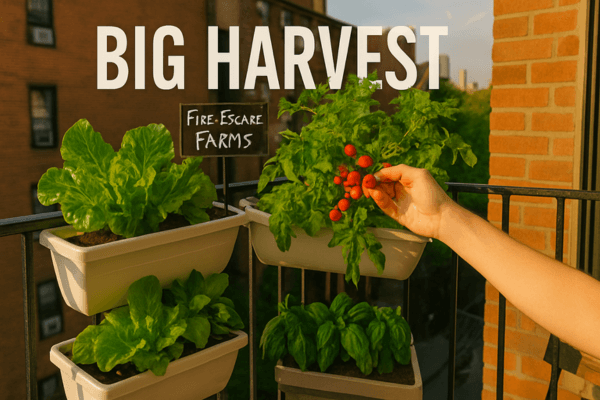
Real-Life Vertical Gardens: Urban Jungle Inspiration
Need proof that vertical gardening works in real cities, with real people? These stories will convince even the most skeptical apartment dweller that anyone can grow up—literally.
1. Small Space, Big Harvest: Urban Success Stories
The Fire Escape Farm (Brooklyn, NY)
- Challenge: 200 sq ft apartment, north-facing fire escape.
- Solution: Hanging gutter planters bolted to railings + compact varieties like ‘Tiny Tim’ tomatoes.
- Result: 15 lbs of produce per season (enough for weekly salads).
“I grow more food on my fire escape than my parents do in their backyard.” — Mark, @FireEscapeFarms
The Balcony Jungle (Tokyo, Japan)
- Challenge: 4 sq meter balcony in a shaded high-rise.
- Solution: 3-tiered shelves with LED grow lights + humidity-loving ferns and shiso herbs.
- Result: A private green retreat in one of the world’s densest cities.
The Indoor Herb Wall (Berlin, Germany)
- Challenge: Zero outdoor space, dark German winters.
- Solution: Repurposed IKEA spice racks + hydroponic basil and mint.
- Result: Year-round cocktail ingredients with no grocery runs.
2. Community Projects Changing Cities
The “Gangster Garden” (Detroit, USA)
📍 Vacant lot turned vertical farm
- How: Local teens built 8-foot pallet towers to grow kale and peppers.
- Impact: Supplies 20% of a nearby soup kitchen’s fresh produce.
The Subway Garden (London, UK)
📍 Disused telephone booth
- How: Residents transformed a red phone booth into a moss-and-succulent vertical garden.
- Impact: Sparked 12 more “phone booth gardens” across the city.
The Rooftop Swap (Singapore)
📍 Public housing estate
- How: Monthly plant swaps where neighbors trade cuttings and vertical gardening tips.
- Impact: Over 100 families now grow food collectively.
3. What These Stories Teach Us
- Start Small: Many began with just one pallet or shelf.
- Use What You Have: Fire escapes, walls, even old furniture can become gardens.
- Community = Power: Shared knowledge and resources multiply success.
Try This: Visit your local community garden—most offer free workshops on vertical techniques.
Want help finding similar projects near you? Tell me your city—I’ll research local inspiration! 🌆
Next Up: Your turn! We’ll walk through designing a personalized vertical garden plan.
Grow Up, Not Out: Your Vertical Garden Journey Starts Here
We’ve dug deep into the world of vertical gardening—from upcycled planters to foolproof plant picks—and one thing is clear: you don’t need space to grow; you just need creativity. Whether you’re a black-thumbed beginner or a budding green guru, vertical gardens offer a simple, sustainable way to bring nature into even the tiniest urban nook.
Why It’s Worth It (A Quick Recap)
✔ Space-Smart: Turn blank walls, balconies, and windowsills into lush, productive spaces.
✔ Eco-Friendly: Reduce your food miles, support pollinators, and breathe cleaner air.
✔ Stress-Busting: Few things beat the pride of snipping homegrown herbs for dinner.
Your Next Steps (No Pressure!)
- Start Small: One hanging bottle planter or a single pallet is enough to begin.
- Embrace Trial & Error: Killed a plant? Join the club. Even “failures” teach you something.
- Make It Yours: Paint those upcycled containers neon pink. Grow absurdly hot peppers. This is your green escape.
Now Over to You!
We want to see what you create:
🌿 Tag your projects #VerticalVictories for a chance to be featured
💬 Comment below with your biggest vertical gardening question
📸 DM us your before/after shots—we’ll cheer you on!
Remember: Every jungle started with a single plant. Yours begins today.
P.S. Bookmark this guide and revisit it in 3 months—you’ll be amazed how much you’ve grown (literally). Happy planting! 🌱

